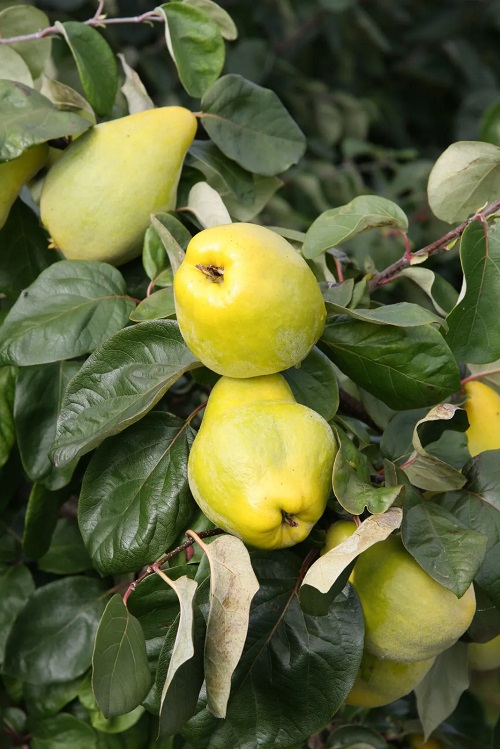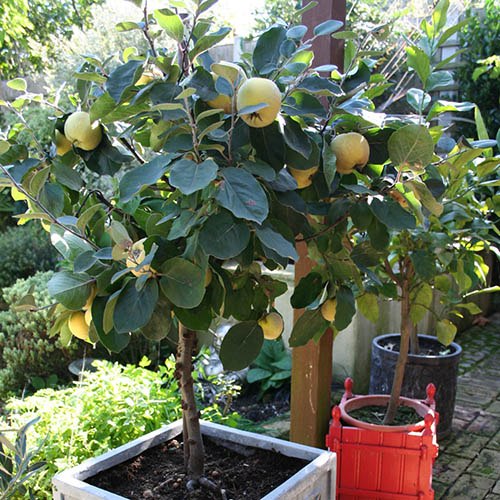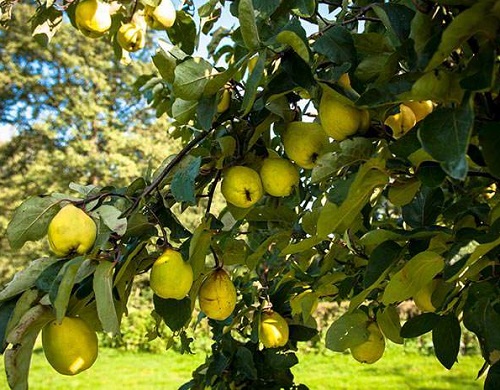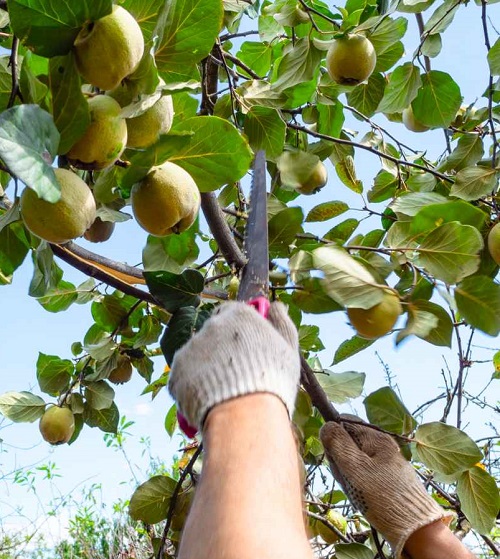Here’s a detailed insight on Quince Fruit Tree Care that will give you a complete idea on how to grow this tasty fruit easily!
Quince Fruit are prized for their fragrant, flavorful fruit and beautiful blossoms. We’ll guide you into growing this tasty fruit with ease in containers!
Botanical Name: Cydonia oblonga
USDA Zones: 5-10
Check out the best pinks fruits here
Quince Fruit Information
Origin
- Historical Roots: Quince Fruit is believed to have originated in the Caucasus region, including countries like Turkey, Iran, and Armenia.
- Cultural Significance: It has been cultivated for over 4,000 years and often appears in ancient Greek and Roman texts. Some even argue that the “golden apple” in Greek mythology was a quince.
Taste
- Raw Taste: Raw Quince Fruit is extremely tart and astringent. Its high tannin content makes it almost inedible raw for most people.
- Cooked Taste: When cooked, Quince Fruit transforms into a sweet and fragrant fruit, often used in jams, jellies, and desserts. It has a flavor that resembles a combination of apple and pear with a hint of citrus.
Flowers
- Appearance: Quince flowers are typically a pale pink to white color. They’re quite beautiful, featuring five petals and a pleasant scent.
- Blossom Time: Quince Fruit trees bloom in late spring, and the flowers are often used in ornamental landscaping.
Fruit Appearance
- Shape and Size: Quince Fruit is pear-shaped, with a broad base that narrows towards the stem. It can vary in size but usually ranges from 3 to 5 inches in length.
- Color: The skin of the quince is golden-yellow when ripe. It has a somewhat fuzzy texture, akin to the feel of a peach but less pronounced.
- Interior: The flesh of the Quince Fruit is pale and hard when raw. It softens when cooked, taking on a pinkish hue and a much more palatable texture.
Aloe Hercules Care | How to Grow Tree Aloe in Pots
Propagating Quince Fruit
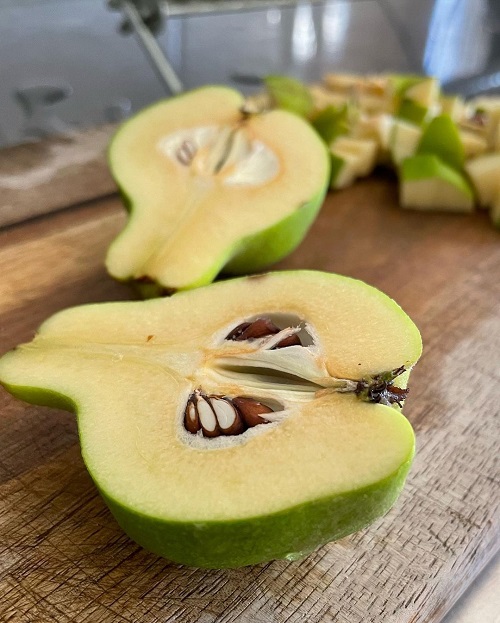
Ways to Propagate Quince Fruit:
- Seed Propagation
- Cuttings
- Layering
- Grafting
- Division
The Most Popular and Reliable Method: Grafting
Grafting is a widely used and reliable method of propagation for many fruit trees, including quince. It involves joining a piece of a mature tree (called the scion) onto a rootstock (a tree grown specifically for its roots). Here’s a detailed explanation of grafting quince:
Steps for Grafting Quince:
- Selection of Rootstock: Choose a young Quince Fruit tree or a suitable rootstock tree. This serves as the base and provides the roots for the grafted tree.
- Selection of Scion: From a mature and healthy Quince Fruit tree, select a young shoot with several buds. This piece, typically 6-8 inches long, will be the scion.
- Prepare the Rootstock: Make a clean, sloping cut on the rootstock where you want the graft to be. This is usually done on the main stem or a major branch, depending on the desired tree shape and size.
- Prepare the Scion: Cut the base of the scion in a similar sloping manner so that it matches the cut on the rootstock.
- Joining: Place the scion onto the rootstock, ensuring the cut surfaces match and make full contact. The cambium layers (the thin layer between the bark and wood) of both pieces need to align for the graft to be successful.
- Binding: Securely bind the joined pieces with grafting tape or a rubber band, ensuring there’s firm contact between the cuts.
- Healing: Over time, the scion and rootstock will grow together and fuse. This can take several weeks to months, depending on the conditions.
- Aftercare: Once the graft has taken and shows signs of growth (e.g., buds on the scion start to grow), you can remove the binding. Monitor the graft site for any signs of disease or failure and protect it from extreme conditions.
Advantages of Grafting:
- Faster Fruit Production: Grafted Quince Fruit trees tend to produce fruit faster than trees grown from seeds.
- Replication: Grafting allows you to replicate the exact characteristics of a specific tree, ensuring consistency in fruit quality.
- Space Saving: Several different Quince Fruit varieties can be grafted onto a single tree, allowing for multiple fruit types without the need for multiple trees.
- Disease Resistance: Using disease-resistant rootstocks can improve the overall health and resilience of the grafted tree.
Note: You can propagate Quince Fruit by seed, but it will take too much time. In the fall, harvest the seeds from ripe fruits, wash them, and place them in the sand. Store the seeds in a cool location until planting them in late winter or early spring.
Choosing a Container for Quince Fruits
Quince trees, known for their fragrant blossoms and versatile fruits, can be grown in containers, allowing even those with limited garden space to enjoy their beauty and bounty. To set the stage for healthy quince growth, consider the following factors when choosing a container.
- Size: The size of the container plays a pivotal role in the overall health and growth of your quince tree. Opt for a 20-24 inches container that’s equally deep.
- Material: Choose a material that aligns with your climate, aesthetic preferences, and maintenance capabilities. Plastic and fiberglass containers are lightweight and retain moisture well, while wooden containers can provide a natural aesthetic and insulate roots from temperature extremes.
- Drainage: Proper drainage is essential to prevent waterlogged roots, which can lead to root rot. Ensure that the chosen container has multiple drainage holes at the bottom.
Here are Plant Pot Sizes from Inches to Gallon
Requirements for Growing Quince Fruit
Quince Fruit trees, known for their beautiful blossoms and aromatic fruits, have specific requirements to ensure they grow and produce optimally. Here’s a detailed breakdown of the requirements for growing quince fruit:
Sunlight
- Intensity: Quince Fruit trees prefer full sun. This means they should receive at least 6-8 hours of direct sunlight every day.
- Protection: While they love sunlight, young trees can benefit from some shade during the hottest parts of the day. As they mature, full sun becomes less of an issue.
Soil
- Type: Quince Fruit trees prefer well-draining soil. Loamy or sandy loam soils are ideal. They don’t do well in heavy, waterlogged soils.
- pH Level: A slightly acidic to neutral pH range of 6.0 to 7.5 is best for quince trees. If unsure about your soil’s pH, you can get a testing kit from most garden centers.
- Fertility: Before planting, enriching the soil with well-decomposed compost or organic matter can boost its fertility and improve structure. This ensures the young tree has all the nutrients it needs to establish itself.
- Depth: A deep soil bed is beneficial, as quince trees have a strong taproot. While choosing a pot, go for a container that’s deeper than wider.
Watering
- Frequency: Regular watering is essential, especially for young Quince Fruit trees. Once established, they can tolerate some drought, but it’s always best to ensure they have consistent moisture.
- Method: Deep watering is more effective than frequent shallow watering. It encourages deeper root growth, making the tree more drought-resistant.
Yellowing leaves can be a sign of too much water. Ensure the soil doesn’t stay waterlogged, as this can lead to root rot.
Temperature
- Hardiness: Quince Fruit is relatively hardy and can tolerate winter temperatures. It falls in USDA hardiness zones 5-9.
- Bloom Sensitivity: While the tree itself is hardy, the blossoms can be susceptible to late spring frosts. Planting in a location protected from cold winds and late frosts can be beneficial.
Quince Fruit trees prefer temperate climates with distinct seasons. They appreciate the cold dormancy of winter, followed by the warmth of spring and summer to stimulate growth and fruiting.
Quince Tree Care
Fertilizer
At the Time of Planting:
- Before planting, work into the soil a balanced, slow-release granular fertilizer, such as a 10-10-10. Follow the manufacturer’s recommended dose for a young tree. This usually ranges from 1 to 3 pounds per tree, but it’s vital to check the product label.
First Growing Season:
- Wait until the tree has shown some growth before adding additional fertilizer.
- Approximately 6 weeks after planting, you can apply half a cup of a 10-10-10 fertilizer spread in a circle around the tree, about 18 inches from the trunk.
- Repeat this application about 6 weeks later.
Subsequent Years:
- Second Year: Apply 1 cup of 10-10-10 in the early spring before growth starts and again in early summer.
- Third Year and Beyond: Apply 2 cups in early spring and again in early summer.
Mature Trees (over 4 years old):
-
- Mature trees might not need as frequent fertilization.
- Use 1 to 2 pounds of 10-10-10 per inch of trunk diameter, measured at chest height. Spread this around the drip line of the tree in early spring.
Note: You can also use a balanced liquid fertilizer. Do refer to the label for dosage and instructions. If you have any doubts, take the help of the local garden center.
Mulching
Mulch helps retain soil moisture, suppress weeds, and regulate soil temperature. Use organic mulch like straw, wood chips, or shredded bark around the base of the tree, but ensure it’s not touching the trunk directly to avoid rot.
A depth of 2-4 inches is typically recommended.
Pruning
Prune to maintain an open canopy that allows sunlight and air circulation. This helps reduce the incidence of diseases. Remove dead, diseased, or crossed branches from time to time, whenever you spot them on the Quince Fruit tree.
Pests
- Codling Moth: The larvae burrow into the fruit. Use pheromone traps or organic insecticides.
- Aphids: These suck sap from young shoots. They can be controlled with neem oil or insecticidal soaps.
- Fruit Flies: These can lay eggs in the fruit, causing spoilage. Use traps or insect nets.
- Birds: Can peck at the fruit. Bird netting or scare devices can be useful.
Diseases
- Quince Leaf Blight: Caused by a fungus, it results in spots on leaves. Good sanitation (like cleaning up fallen leaves) can help prevent this.
- Fire Blight: This bacterial disease causes wilting and blackening of branches. Prune infected parts and avoid excess nitrogen fertilization which can exacerbate the problem.
- Quince Rust: Shows up as raised, orange spots on the underside of leaves. Pruning for better air circulation and using fungicides can help manage it.
Here are the Best Organic Pest Control Approaches Every Gardener Should Know
Harvesting and Storing Quince Fruits

Maturing After Propagation:
- From Seed: If you start a Quince Fruit tree from seed, it might take anywhere from 5 to 8 years or more before it starts producing fruit. This method is less predictable in terms of fruit quality.
- From Grafted Trees: Trees obtained from nurseries are usually grafted and will start bearing fruit much sooner, typically around 3 to 5 years after planting.
Days to Harvest:
- Quince Fruits typically take about 5 to 6 months to mature after flowering, but this can vary depending on the variety and growing conditions. They are usually ready for harvest in late summer to early fall.
Signs the Fruit is Ready to be Picked:
- Color: The fruit changes from green to a bright yellow or light golden color when mature.
- Fragrance: A mature quince has a strong, fragrant aroma.
- Texture: Quince Fruit will still be quite hard when it’s ripe, unlike many other fruits.
- Taste Test: If you’re unsure, pick one fruit and taste it. If it’s slightly sweet and aromatic, the rest are likely ready for harvest.
It’s essential to note that quinces are rarely eaten raw due to their astringency and hardness. They’re mostly cooked to bring out their sweet and fragrant flavor.
Taste When Ripe:
- Raw Quince Fruit is tart and somewhat astringent even when fully ripe. However, when cooked, it turns sweet and has a unique, aromatic flavor reminiscent of apples and pears with floral undertones.
Storing Quince Fruits:
- Short Term: Store Quince Fruits at room temperature if you plan to use them within a week or so.
- Long Term: For extended storage, keep Quince Fruits in a cool, dark place, like a cellar, or in the refrigerator. They can last for several weeks to a couple of months when stored correctly.
- Cooked or Processed: Quinces can be made into jellies, jams, pastes (like membrillo), or poached in syrup. These preparations can be stored longer. Jellies and jams, for instance, can be canned and stored for up to a year in a cool, dark place. Once opened or if cooked without preservation methods, they should be refrigerated and used within a week or so.
Here is How to Grow Calathea
FAQs
1. Can Quince Trees Be Grown Indoors as Well?
Yes, quince trees can be grown indoors, but they require proper care and attention to sunlight, humidity, and space. You may need to consider providing additional humidity, especially in dry indoor environments. Choose a suitable dwarf or compact variety that is well-suited for container cultivation.
2. Are There Any Specific Pollination Requirements for Quince Trees?
Yes, many quince varieties require cross-pollination to produce fruit. This means you’ll need at least two compatible quince trees or a compatible pollinator nearby to ensure a fruit set. Bees and other pollinators play a crucial role in transferring pollen between the trees.
3. Can I Grow Quince Trees From Cuttings?
Yes, quince trees can be propagated from hardwood cuttings taken during the dormant season. Choose healthy, disease-free branches, cut them into sections with multiple buds, and plant them in well-draining soil. Keep the cuttings moist and protected from extreme temperatures until they establish roots.

